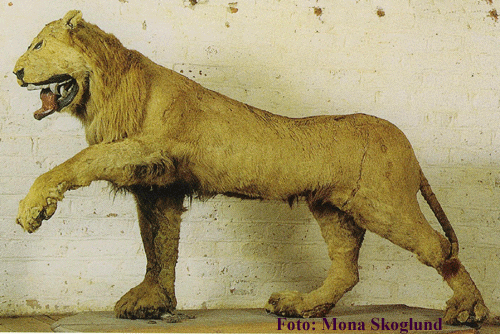This is, or rather was, a Lion. How did this happen to a majestic king of the Saranghetti? The story goes that in 1731 King Frederick I of Sweden received a lion as a gift from the Bey of Algiers, and was so enamored with the beast that when it died he tried to have the beast taxidermied. After all, what was a source of prestige in life could continue long after death when properly stuffed and mounted.
The only trouble was that for whatever reason, the taxidermist was only given the pelt and the bones of the beast to work from. The story goes that the poor taxidermist, lacking the modern conveniences of Wikipedia and Google image search just didn’t have the find understanding of large feline bone structure to put together a convincing facsimile. What you see above is the result.
Now, I am no expert, but I think that’s only half the story, because when seen from the side the lion actually has quite a ferocious appearance.
In this context, the lion’s bizarre tongue and fake teeth make some kind of sense. Even the close-set position of the eyes seems to have been done in order to make them appear furrowed and angry. Perhaps the taxidermist simply focused too much on side-view images when mounting the pelt, or the lion was (somehow) never intended to be seen from more than one angle. We’ll likely never know the truth about what happened to King Frederick’s lion, but its bizarre appearance has given it a measure of immortality that mere taxidermy never could. In that way, the unnamed taxidermist truly out did himself.

(The Daily What, As Good as it Gets via Neatorama)








Published: Apr 11, 2011 02:56 pm